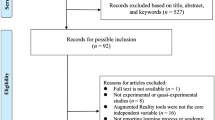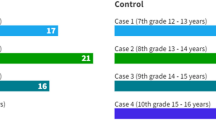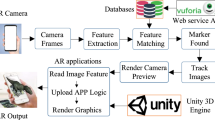Abstract
Teaching the complex subject matter of “Exploring Space” necessitates concrete and engaging teaching methods, as it requires students to employ abstract thinking and imagination. An expert team designed and developed Augmented Reality (AR)-based activity schemes for children aged 3–6. A total of 166 preschool students from Ningbo, China, were conveniently sampled to participate in six science activity units. 82 students received AR-based instruction, while 84 were taught using conventional methods. This research employed the “Preschool Learning Behaviors Scale (PLBS)”, “Attitude on Science in School Assessment (ATSSA)”, as well as “Attitude on AR Activities Scale (ARAAS)” to compare the impact of virtual manipulatives based on AR, as well as physical manipulatives on preschool students’ academic accomplishments and attitudes. Outcomes demonstrated that the AR-based science learning system promoted more active learning behaviors and improved learning attitudes. ANOVA analysis verified that AR receptivity remarkably influenced learning attitudes and behaviors, with learning attitudes also remarkably impacting learning behaviors. Furthermore, students exhibited high acceptance of AR technology in science activities.




Similar content being viewed by others

Data availability
The information is available from the corresponding author upon request.
References
Abdüsselam, M. S. (2014). Teachers’ and students’ views on using augmented reality environments in physics education: 11th grade magnetism topic example. Pegem Journal of Education and Instruction, 4(1), 59–74.
Buchner, J. (2022). Generative learning strategies do not diminish primary students’ attitudes towards augmented reality. Education and Information Technologies, 27(1), 701–717. https://doi.org/10.1007/s10639-021-10445-y
Cabell, S. Q., DeCoster, J., LoCasale-Crouch, J., Hamre, B. K., & Pianta, R. C. (2013). Variation in the effectiveness of instructional interactions across preschool classroom settings and learning activities. Early Childhood Research Quarterly, 28(4), 820–830.
Cai, S., Wang, X., & Chiang, F. K. (2014). A case study of augmented reality simulation system application in a chemistry course. Computers in Human Behavior, 37, 31–40.
Delello, J. A. (2014). Insights from pre-service teachers using science-based augmented reality. Journal of computers in education, 1, 295–311. https://doi.org/10.1007/s40692-014-0021-y
Di Serio, Á., Ibáñez, M. B., & Delgado-Kloos, C. D. (2013). Impact of an augmented reality system on students' motivation for a visual art course. Computers & Education, 68, 586–596.
Domínguez, X., Vitiello, V. E., Maier, M. F., & Greenfield, D. B. (2010). A longitudinal examination of young children’s learning behavior: Child-level and classroom-level predictors of change throughout the preschool year. School Psychology Review, 39(1), 29–47.
Early, D. M., Iruka, I. U., Ritchie, S., Barbarin, O. A., Winn, D. M. C., Crawford, G. M., & Pianta, R. C. (2010). How do pre-kindergarteners spend their time? Gender, ethnicity, and income as predictors of experiences in pre-kindergarten classrooms. Early Childhood Research Quarterly, 25(2), 177–193.
Erbas, C., & Demirer, V. (2019). The effects of augmented reality on students' academic achievement and motivation in a biology course. Journal of Computer Assisted Learning, 35(3), 450–458.
Escalón, X. D., & Greenfield, D. (2009). Learning behaviors mediating the effects of behavior problems on academic outcomes. NHSA Dialog, 12(1), 1–17.
Gelman, R., & Brenneman, K. (2004). Science learning pathways for young children. Early Childhood Research Quarterly, 19(1), 150–158.
Gerde, H. K., Schachter, R. E., & Wasik, B. A. (2013). Using the scientific method to guide learning: An integrated approach to early childhood curriculum. Early Childhood Education Journal, 41, 315–323. https://doi.org/10.1007/s10643-013-0579-4
Germann, P. J. (1988). Development of the attitude toward science in school assessment and its use to investigate the relationship between science achievement and attitude toward science in school. Journal of research in science teaching, 25(8), 689–703.
Gopalan, V., Bakar, J. A. A., & Zulkifli, A. N. (2023). Systematic literature review on critical success factors in implementing augmented reality for science learning environment (2006–2021). Education and Information Technologies, 1-28. https://doi.org/10.1007/s10639-023-11613-y
Gredler, M. E. (2012). Understanding Vygotsky for the classroom: Is it too late? Educational Psychology Review, 24, 113–131.
Hamre, B. K., Pianta, R. C., Downer, J. T., DeCoster, J., Mashburn, A. J., Jones, S. M., & Hamagami, A. (2013). Teaching through interactions: Testing a developmental framework of teacher effectiveness in over 4,000 classrooms. The Elementary School Journal, 113(4), 461–487.
Hinske, S., & Langheinrich, M. (2007). Managing Augmented Toy Environments–A New Perspective for Smart Space Management. In Proceedings of the 4th International Workshop on Managing Ubiquitous Communications and Services (MUCS).
Hinske S., Langheinrich M., & Lampe M. (2008). Towards guidelines for designing augmented toy environments. In Proceedings of the 7th ACM conference on Designing interactive systems (pp. 78–87).
Hong, S. Y., & Diamond, K. E. (2012). Two approaches to teaching young children science concepts, vocabulary, and scientific problem-solving skills. Early Childhood Research Quarterly, 27(2), 295–305.
Kerawalla, L., Luckin, R., Seljeflot, S., & Woolard, A. (2006). “Making it real”: Exploring the potential of augmented reality for teaching primary school science. Virtual Reality, 10, 163–174. https://doi.org/10.1007/s10055-006-0036-4
Klahr, D. (2019). Learning sciences research and Pasteur’s quadrant. Journal of the Learning Sciences, 28(2), 153–159.
Küçük, S., Yilmaz, R., Baydas, Ö., & Göktas, Y. (2014). Augmented reality applications attitude scale in secondary schools: Validity and reliability study. Egitim ve Bilim, 39(176), 383–392.
Liarokapis, F., & Anderson, E. F. (2010). Using augmented reality as a medium to assist teaching in higher education. In Eurographics 2010 (pp. 9–16). Norrköping.
Lu, S. J., Liu, Y. C., Chen, P. J., & Hsieh, M. R. (2020). Evaluation of AR embedded physical puzzle game on students’ learning achievement and motivation on elementary natural science. Interactive Learning Environments, 28(4), 451–463.
Mantzicopoulos, P., Patrick, H., & Samarapungavan, A. (2008). Young children’s motivational beliefs about learning science. Early Childhood Research Quarterly, 23(3), 378–394.
Mashburn, A. J., Pianta, R. C., Hamre, B. K., Downer, J. T., Barbarin, O. A., Bryant, D., & Howes, C. (2008). Measures of classroom quality in prekindergarten and children’s development of academic, language, and social skills. Child Development, 79(3), 732–749.
McDermott, P. A. (1999). National scales of differential learning behaviors among American children and adolescents. School Psychology Review, 28(2), 280–291.
McDermott, P. A., Leigh, N. M., & Perry, M. A. (2002). Development and validation of the preschool learning behaviors scale. Psychology in the Schools, 39(4), 353–365.
McDermott, R., Goldman, S., & Varenne, H. (2006). The cultural work of learning disabilities. Educational Researcher, 35(6), 12–17.
McMillan, J. H., & Schumacher, S. (2010). Research in education: Evidence-based inquiry. MyEducationLab Series.
Murphy, C., & Beggs, J. (2003). Children’s perceptions of school science. School science review, 84, 109–116.
National Research Council. (2008). Adolescent health services: Missing opportunities.
National Research Council. (2012). A framework for K-12 science education: Practices, crosscutting concepts, and core ideas. National Academies Press.
Nayfeld, I., Brenneman, K., & Gelman, R. (2011). Science in the classroom: Finding a balance between autonomous exploration and teacher-led instruction in preschool settings. Early Education & Development, 22(6), 970–988.
Nayfeld, I., Fuccillo, J., & Greenfield, D. B. (2013). Executive functions in early learning: Extending the relationship between executive functions and school readiness to science. Learning and Individual Differences, 26, 81–88.
Osborne, J., Simon, S., & Collins, S. (2003). Attitudes towards science: A review of the literature and its implications. International journal of science education, 25(9), 1049–1079.
Peleg, R., & Baram-Tsabari, A. (2011). Atom surprise: Using theatre in primary science education. Journal of Science Education and Technology, 20, 508–524.
Piasta, S. B., Pelatti, C. Y., & Miller, H. L. (2014). Mathematics and science learning opportunities in preschool classrooms. Early Education and Development, 25(4), 445–468.
Reid, T. (2014). Development and validation of an instrument assessing preschool children's attitude towards science (Doctoral dissertation, [Honolulu]:[University of Hawaii at Manoa],[August 2014]).
Sahin, D., & Yilmaz, R. M. (2020). The effect of augmented reality technology on middle school students' achievements and attitudes towards science education. Computers & Education, 144, 103710.
Silver, A., & Rushton, B. S. (2008). Primary-school children's attitudes towards science, engineering and technology and their images of scientists and engineers. Education 3–13, 36(1), 51-67.
Sullivan, A., & Bers, M. U. (2016). Robotics in the early childhood classroom: Learning outcomes from an 8-week robotics curriculum in pre-kindergarten through second grade. International Journal of Technology and Design Education, 26, 3–20. https://doi.org/10.1007/s10798-015-9304-5
Thamburaj, K. P. (2015). Promoting scientific ideas through the future studies in Tamil language teaching. Procedia-Social and Behavioral Sciences, 174, 2084–2089.
Wojciechowski, R., & Cellary, W. (2013). Evaluation of learners’ attitude toward learning in ARIES augmented reality environments. Computers & Education, 68, 570–585.
Yee, M. A., Gregory, A., Allen, J. P., Pianta, R. C., & Lun, J. (2011). Effects of a teacher professional development intervention on peer relationships in secondary classrooms. School Psychology Review, 40(3), 367–385.
Yildirim, B. (2016). An analyses and Meta-synthesis of research on STEM education. Journal of Education and Practice, 7(34), 23–33.
Zucker, T. A., Cabell, S. Q., Justice, L. M., Pentimonti, J. M., & Kaderavek, J. N. (2013). The role of frequent, interactive prekindergarten shared reading in the longitudinal development of language and literacy skills. Developmental Psychology, 49(8), 1425.
Acknowledgements
We express our gratitude to Wenqian Zou of Ningbo Childhood Education College, China, for their valuable feedback on this article.
Author information
Authors and Affiliations
Contributions
Y.Z. conceived the idea; Y.Z. developed the methodology; J.S. performed validation; J.S. wrote the formal assessment; Y.Z. carried out the investigation; Y.Z. provided resources; Y.Z. drafted the original manuscript; J.S. reviewed and edited the manuscript; J.S. supervised the project; J.S. administered the project; all authors read and approved the final edition of the manuscript.
Corresponding author
Ethics declarations
Institutional review board statement
Not applicable.
Informed consent
All participants gave their informed consent to participate in this study.
Competing interests
The authors declare that they have no competing interests.
Conflict of interest
There are no conflicts of interest reported by the authors.
Additional information
Publisher’s note
Springer Nature remains neutral with regard to jurisdictional claims in published maps and institutional affiliations.
Rights and permissions
Springer Nature or its licensor (e.g. a society or other partner) holds exclusive rights to this article under a publishing agreement with the author(s) or other rightsholder(s); author self-archiving of the accepted manuscript version of this article is solely governed by the terms of such publishing agreement and applicable law.
About this article
Cite this article
Zhufeng, Y., Sitthiworachart, J. Effect of augmented reality technology on learning behavior and attitudes of preschool students in science activities. Educ Inf Technol 29, 4763–4784 (2024). https://doi.org/10.1007/s10639-023-12012-z
Received:
Accepted:
Published:
Issue Date:
DOI: https://doi.org/10.1007/s10639-023-12012-z



